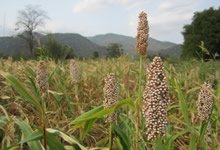Ninety kilometres of potholed dirt road from the nearest market town, the village of Endau in Machakos County, central Kenya, is an unlikely place for a revolution. It’s a semi-arid area that in recent years has struggled to produce a maize crop from nutrient depleted, rain starved soils, where stored crops are routinely subject to pest infestation and buyers are few. Recently, however, I visited Endau to see the progress of a new project being run by the Pan African Agribusiness and Agro-Industry Coalition (PanAAC), an African not-for-profit organisation which seeks to strengthen rural African value chains as a means of fighting poverty and hunger.
PanAAC has been working with local smallholder farmers to shift from growing maize to growing sorghum, which grows well in semi-arid areas like Endau because of the crop’s tolerance to drought and heat. And once we arrived in the village itself, the reason for championing sorghum was clear: while the maize crops we saw had dried up and failed to produce ears, the sorghum in neighbouring fields seemed to be flourishing.
Read on: New Agriculturist: Focus on… Revolutionary road trip on the sorghum trail.


